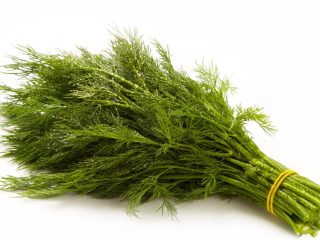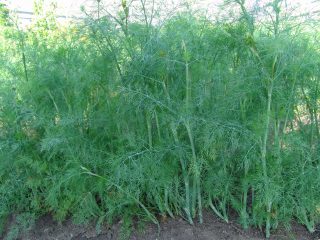Content
Dill sprouts at different times after sowing, but approximately this occurs on days 14-25. The germination of a crop is greatly influenced by the planting location, seed quality, ambient temperature and other external factors. This plant is considered undemanding and can grow almost on its own, but for its good yield it is necessary to create the right conditions for planting.

Dill is a spicy herb, widely used not only in cooking, but also in medicine.
How quickly do dill seeds sprout?
How many days it will take for dill to sprout is judged by many criteria, but the main thing is the planting location. It was also noticed that if the soil where the material is sown is heated to +12 ° C, then the first shoots already appear 12-14 days after planting, at a temperature of +10 ° C a week later, and if the seeds are planted in open soil dry, they germinate in about 25 days.
How long does it take for dill seeds to germinate in open ground?
In unprotected soil, dill seeds planted in spring usually germinate 15-18 days after work. If the air temperature during the day stays within +20 °C, this will happen five days faster. When planting a plant before winter, it sprouts almost immediately with the onset of constant warm days.
How long does it take for dill to sprout in a greenhouse?
Dill for greens in a greenhouse grows in any weather and germinates quite quickly. But this indicator in practice depends on temperature and watering, as well as the specific plant variety: early varieties sprout after 12 days, mid-early varieties after 15-18, late varieties appear after three weeks.

In the greenhouse, spicy greens grow stronger and healthier
On what day does dill sprout on the windowsill?
If you grow dill at home on a windowsill and provide it with long daylight hours, then at a room temperature of +20-22 °C it will sprout within ten days after sowing.
What affects the germination of dill seeds
Dill seeds remain viable for quite a long time. So, in the first 3-4 years its indicators are high, but in subsequent months they begin to gradually decrease and over time the seedlings germinate more and more slowly. In addition, their germination is influenced by other factors, such as crop variety, weather conditions, preparation of materials, etc.

For a good dill harvest, it is important to choose high-quality planting material and follow the recommended rules of agricultural technology
Variety selection
In many ways, the time at which dill sprouts appear depends on the type of crop.Early ripening varieties germinate earlier, late ones - a little later.
The best early ripening varieties, judging by numerous reviews from gardeners, are Gribovskii and Avrora. They are perfect for regions of the middle zone and southern latitudes. Mid-season varieties, such as Lesnogorodskii or Kustistyy, are also considered good. They can be grown both indoors and outdoors; they germinate approximately 20 days after sowing, which is a little later than early varieties. Late species, such as Dill, grow the longest. They are usually planted in greenhouses, they produce lush green mass, contain the highest amount of vitamins, and are better for storage and transportation.
Seed preparation
The quality of planting material also affects further results. For planting, it is better to take young seeds, no older than 24 months. You can plant self-collected seedlings or store-bought ones. Before work, it is advisable to rid them of excess essential oil and soak them for several days, so they will sprout faster. Seeds that float to the surface of the water are not used for planting.
Weather
Despite the fact that the plant is frost-resistant and easily tolerates cold temperatures down to -6 °C, dill germinates well at temperatures above +10 °C. If the weather suddenly deteriorates, the process of seed germination is slowed down. Therefore, you should not immediately plant them in open ground; it is better to wait until the frosts have finally passed and the temperature becomes positive and stable.

Garden crops love warmth and grow faster in such weather conditions
Soil condition
The quality of the soil in which it was planted plays a significant role in the good germination of dill seeds. The plant grows better in fertile and nutrient-rich soil. It is advisable to feed the area where the crop will grow with complex or organic mixtures. The chemical composition of the earth also matters.
Landing dates
Experts advise planting dill in open ground only when it is sufficiently warmed up. In cold soil, seedlings take a long time to germinate. In the middle zone, the crop begins to be sown for early greenery in the second half of April, in the southern regions - at the beginning of this month.
The crop can also be sown in summer and even autumn. If planted before winter, sprouts may appear after the snow melts with the arrival of the first sunny days.

Dill sown in autumn feeds on melt water and grows very actively.
Lighting
In order for dill seedlings to be healthy and strong, as well as to grow evenly and harmoniously, care should be taken to ensure proper lighting of the plantings. Dill loves light, so it needs to be placed in a sunny area. When grown at home, containers with the crop are placed on light windowsills, and, if necessary, additional lighting is provided with special lamps.

If there is insufficient lighting, the dill will stretch out, the seedlings will become pale and weak
Landing
When sowing a crop, it is important to follow a number of rules, since deviations from the norms can greatly affect the quality and period of its germination. Attention should be paid to the following points:
- Be sure to plant in moist soil. At home or in a greenhouse, without preliminary moistening, seedlings will not gain the required amount of moisture, and outside they will be able to sprout only after precipitation has fallen.
- When planting already sprouted seedlings, they should be placed in the ground very carefully so as not to damage the shoots.
- Do not place the seeds too deep. Planting them by 2 cm or more greatly delays the germination date.
- Do not plant densely. The gap between the furrows should be at least 4 cm.
- At home, it is better to sow dill on top of the ground, then sprinkle it with a little soil.
- It is recommended to thin out thickened seedlings.
What do dill seedlings look like from a photo?
Healthy dill sprouts (photo below) are bright green and strong. A week after the emergence of shoots, they become lush, the branches do not droop. In the first few days they may have a pale color and be tender and weak, but after a week they become strong.
At first, dill plantings may be dense, and for their normal growth, thinning should be done. The interval between seedlings should be left about 2-3 cm.

Dill is planted on the same plot of land no earlier than four years later.
Why doesn't dill sprout?
Despite the fact that any gardener can cope with growing this useful herb, it happens that the seeds do not begin to sprout for a while or this happens poorly. If the dill does not sprout, then you have to sow it again, which significantly delays the harvest time. Several reasons could be to blame. To avoid this, you need to familiarize yourself with them:
- Insufficient or poor quality watering. The soil where the crop grows must be well moistened. The beds need to be watered regularly, otherwise the seedlings will germinate late and their leaves will be light yellow in color.
- Deep landing. When sowing seeds deep into the ground, you have to wait a very long time for seedlings to emerge. They need to be embedded into the ground to a maximum depth of 15 mm. Some gardeners simply scatter seedlings on the surface of the ground, and then cover them with nutrient substrate or sand on top.
- The soil is too fertile. The normal development of any plant, including dill, is affected not only by insufficient, but also by excess amounts of nutrients in the soil. You cannot overfeed young greens.
- Dense sowing. Those dill sprouts that have enough space grow faster. If the seeds are sown densely, the plant will develop poorly. The minimum distance between furrows should be 5 cm, between bushes - 3 cm.
- Lack of disinfection. It is important to treat the area for dill before planting. To do this, it is recommended to spill it with boiling water or a solution prepared from potassium permanganate.
- Unsuitable neighbors. For quick germination, dill beds should be placed next to onions, legumes or strawberries. You cannot plant a plant in a place where Umbrellas grew before.
Conclusion
Dill sprouts a couple of weeks after it is planted. If this is done at home, then the sprouts appear 2-3 days earlier, if in open ground, then a little later. With proper care and compliance with all requirements, the seedlings will be very friendly, and the greenery will be healthy and lush. It is quite easy to create suitable conditions for grass. Even a novice gardener can cope with this task.








